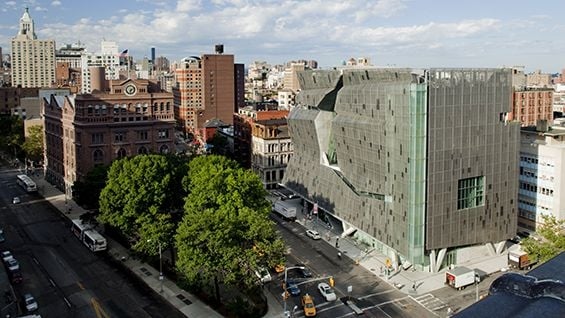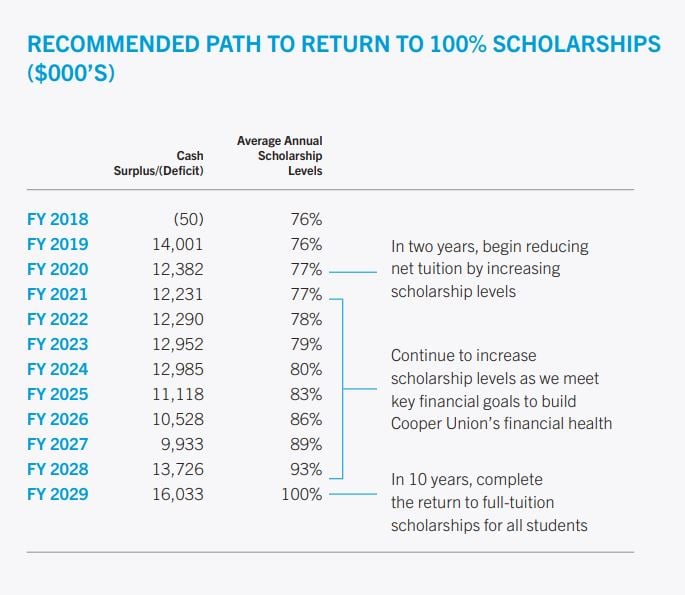You have /5 articles left.
Sign up for a free account or log in.

Cooper Union
Cooper Union has a plan to gradually move back to free tuition for undergraduates over the next 10 years, reversing course from a controversial 2014 decision to start charging.
Scholarships could begin increasing in two years, the private art, architecture and engineering college in New York City announced Thursday, a day after trustees approved the plan. Costs to students will be bought down in increasing amounts over time as administrators find ways to pay for tuition by cutting costs and raising money. They will seek to find $250 million in savings and additional revenue sources over the coming decade in order to boost Cooper Union’s finances to the point where they are deemed strong enough to support free undergraduate tuition.
The plan marks a turnaround from just four years ago, when trustees decided to start charging tuition because of financial concerns. That decision sparked an outcry from some students, professors and alumni who believed it broke with the vision of Peter Cooper, the industrialist who founded the college with a mission of free tuition -- a mission that for generations attracted many top engineering, art and architecture students who were unable to afford traditional colleges.
A group filed a lawsuit attempting to block the college from charging tuition, and the decision led to the resignation of several trustees and then president Jamshed Bharucha. The college, its critics and New York State’s attorney general eventually reached an agreement in 2015 revamping Cooper Union’s governance, requiring more transparency from its board and requiring the board to seek a way to return to free tuition by 2018.
Some former critics lauded the new plan Thursday. But others were unhappy, holding that the college’s financial situation is strong enough to allow it to eliminate tuition much sooner than 10 years from now.
The plan also allows Cooper Union leaders to take more time to cut and eliminate tuition if economic conditions deteriorate and the college’s financials worsen. On the other hand, tuition could be eliminated sooner if financial targets are met ahead of schedule.
“I think there are a lot of people even within Cooper that would love to see us get back to free tuition quicker than in 10 years,” said Laura Sparks, the institution’s president since January 2017, in an interview Thursday evening. “But we wanted to make sure we put a plan in place that was ambitious but also achievable.”
Cooper Union’s undergraduate tuition is listed at $43,250 per year for 2017-18. All first-time enrollees receive scholarships worth half the tuition charge, and additional aid is stacked on top based on students’ demonstrated financial need. Slightly more than a third of students are on full-tuition scholarships, Sparks said.
That translates to an average discount rate of 76 percent. Under the newly approved plan, the scholarship level would increase to 77 percent in 2020 and grow by several points in most years until it hits 100 percent in 2029.
Students would still be responsible for paying fees, although Cooper Union offers nontuition aid to cover fees for students who cannot afford to pay, Sparks said. Many graduate students would also still pay tuition. In fact, the new plan calls for average graduate program scholarships to be cut from 66 percent to 25 percent over five years starting after 2020. A future goal is to increase graduate program scholarships again after undergraduate scholarships have been increased to 100 percent of tuition. Cooper Union decided in 2012 to start charging graduate students tuition.
Other moves to pay for the plan include increasing building and facility rentals, increasing ancillary revenue, and increasing fund-raising revenue by an average of $1.2 million, or 25 percent, annually over the next five years. Over the five following years, the plan calls for increasing fund-raising by 11 percent on average.
(The preceding two paragraphs have been updated to include new information provided by Cooper Union. A plan originally published in January called for graduate scholarship cuts starting in 2019 and for dormitory rates to be increased to the current market rate. But the board changed those provisions in the final plan based on feedback.)
On the side of cutting expenses, the plan calls for cutting both personnel and nonpersonnel costs, changing employee benefits, and cutting rental costs for administrative offices.
Enrollment is expected to hold steady, Sparks said. Cooper Union currently has about 900 undergraduate and graduate students.
The plan received some support from former critics. Mike Essl is an alumnus and member of a group called the Committee to Save Cooper Union. He is also now a dean of the college’s School of Art.
“I am amazed at the plan,” he said in a statement released by Cooper Union. “I think 10 years is a miracle. At the cabinet meeting I was in where the timeline was revealed, I started weeping.”
Not everyone agreed. One critic in the Facebook group Save Cooper Union posted “RIP PETER COOPER’S CU” and went on to say that the founder never would have condoned the new plan. He argued Cooper Union is in a financial position to return to free tuition within three years. But another commenter asked him for a clear case supporting his financial claims and told him, “Enough with the histrionics.”
Cooper Union’s return to free undergraduate tuition comes at a time when New York State has been rolling out its own high-profile free tuition program for undergraduates at public colleges. That program, called the Excelsior Scholarship, was not a source of pressure on Cooper Union, Sparks said. Cooper Union’s board has been exploring free tuition and working to shore up its finances since its agreement with the attorney general.
Nonetheless, Sparks said, she would like to be part of a free tuition movement.
“We really hope that we can lead a larger trend that will reverse the trajectory of increasing tuition costs and a movement toward free tuition for students,” she said. “It would be speculation for me to predict where the broader sector is going to go, but we hope we can be a part of leading a reverse trend.”
Cooper Union is not like many other colleges, however. It owns the land under New York City's Chrysler Building and receives a large amount of revenue from that asset. A step up in revenue from the building put Cooper Union in a position to significantly increase its operating income, along with some expense cuts, Sparks said.
Even with the building, Cooper Union is counting on significant increases in fund-raising to make the new plan work.
“I have my work cut out for me,” Sparks said.





